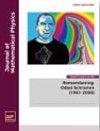单量子系统中的重定标变换和格罗内狄克约束形式主义
IF 1.4
3区 物理与天体物理
Q3 PHYSICS, MATHEMATICAL
引用次数: 0
摘要
在单个量子系统的背景下,使用 "重定标变换 "来研究格罗泰克约束形式主义。重定标变换扩大了单元变换(适用于孤立系统)的范围,它不仅改变波函数的相位,还改变波函数的绝对值,并可与不可逆现象(如量子隧道、阻尼和放大等)联系起来。去量化变换是重定标变换的一个特例,它将希尔伯特空间形式主义映射为标量形式主义。格罗thendieck 形式主义考虑的是取值小于 1 的 "经典 "二次方形式 C(θ),以及取值大于 1 的相应 "量子 "二次方形式 Q(θ),直至复格罗thendieck 常数 kG。研究表明,Q(θ) 可以表示为 θ 与两个重定标矩阵乘积的迹,而 C(θ) 可以表示为 θ 与两个去量化矩阵乘积的迹。Q(θ)在 "超量子 "区域(1,kG)的值非常重要,因为这个区域是经典禁区[C(θ)不能在此取值]。我们给出了一个 Q(θ)∈(1,kG)的例子,它与空间中被高电位隔离的经典区域通过量子隧穿进行通信的现象有关。其他例子表明,根据格罗登第克形式主义(Q(θ)∈(1,kG))的 "超量子性 "与根据其他标准(如量子干涉或不确定性原理)的量子性是不同的。本文章由计算机程序翻译,如有差异,请以英文原文为准。
Rescaling transformations and the Grothendieck bound formalism in a single quantum system
The Grothedieck bound formalism is studied using “rescaling transformations,” in the context of a single quantum system. The rescaling transformations enlarge the set of unitary transformations (which apply to isolated systems), with transformations that change not only the phase but also the absolute value of the wavefunction, and can be linked to irreversible phenomena (e.g., quantum tunneling, damping and amplification, etc). A special case of rescaling transformations are the dequantisation transformations, which map a Hilbert space formalism into a formalism of scalars. The Grothendieck formalism considers a “classical” quadratic form C(θ) which takes values less than 1, and the corresponding “quantum” quadratic form Q(θ) which takes values greater than 1, up to the complex Grothendieck constant kG. It is shown that Q(θ) can be expressed as the trace of the product of θ with two rescaling matrices, and C(θ) can be expressed as the trace of the product of θ with two dequantisation matrices. Values of Q(θ) in the “ultra-quantum” region (1, kG) are very important, because this region is classically forbidden [C(θ) cannot take values in it]. An example with Q(θ)∈(1,kG) is given, which is related to phenomena where classically isolated by high potentials regions of space, communicate through quantum tunneling. Other examples show that “ultra-quantumness” according to the Grothendieck formalism (Q(θ)∈(1,kG)), is different from quantumness according to other criteria (like quantum interference or the uncertainty principle).
求助全文
通过发布文献求助,成功后即可免费获取论文全文。
去求助
来源期刊

Journal of Mathematical Physics
物理-物理:数学物理
CiteScore
2.20
自引率
15.40%
发文量
396
审稿时长
4.3 months
期刊介绍:
Since 1960, the Journal of Mathematical Physics (JMP) has published some of the best papers from outstanding mathematicians and physicists. JMP was the first journal in the field of mathematical physics and publishes research that connects the application of mathematics to problems in physics, as well as illustrates the development of mathematical methods for such applications and for the formulation of physical theories.
The Journal of Mathematical Physics (JMP) features content in all areas of mathematical physics. Specifically, the articles focus on areas of research that illustrate the application of mathematics to problems in physics, the development of mathematical methods for such applications, and for the formulation of physical theories. The mathematics featured in the articles are written so that theoretical physicists can understand them. JMP also publishes review articles on mathematical subjects relevant to physics as well as special issues that combine manuscripts on a topic of current interest to the mathematical physics community.
JMP welcomes original research of the highest quality in all active areas of mathematical physics, including the following:
Partial Differential Equations
Representation Theory and Algebraic Methods
Many Body and Condensed Matter Physics
Quantum Mechanics - General and Nonrelativistic
Quantum Information and Computation
Relativistic Quantum Mechanics, Quantum Field Theory, Quantum Gravity, and String Theory
General Relativity and Gravitation
Dynamical Systems
Classical Mechanics and Classical Fields
Fluids
Statistical Physics
Methods of Mathematical Physics.
 求助内容:
求助内容: 应助结果提醒方式:
应助结果提醒方式:


